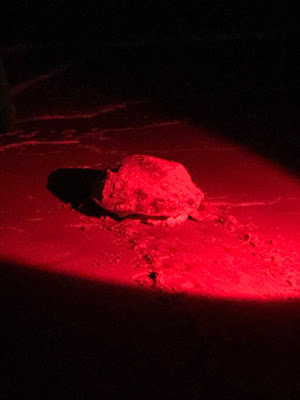Sea Turtle Rescue
Did
You Hear The Good News? |
A once in a lifetime experience occurred on our section of beach at the G
Section at the beginning of June. Two of our Jr. and Sr. Naturalist
participants and their parents spotted a Sea Turtle nesting on the beach. They were
very helpful with keeping people from disturbing the turtle until help could
arrive.
 |
| Meet our Sea Turtle Mom |
Our Master Naturalist and a few Security Teammates rushed to the scene and were able to assist in securing the mother Sea Turtle and her babies. There were approximately 145 eggs in her nest!
 |
| Our Master Naturalist, Brandy, moving the eggs to safety. |
 |
| 145 Sea Turtle Eggs later |
A
crew from the Myrtle Beach State Park assisted us and will keep us updated on the
status of the nest and the baby turtles throughout the Summer.
 |
| A team effort rescue mission |
 |
| Inspecting the nest |
Sea
Turtle 411 | Loggerheads
are the most common species found in South Carolina and were named the official
South Carolina state reptile in 1988!
Let’s
dig in and take a closer look at what happens when it is time for a mother Loggerhead
to begin nesting.
Nesting
| Females will crawl
onto the beach at night, 30 days after breeding, from May to August and deposit
an average of 120 white, leathery eggs, which are about the size of a ping pong
ball. They deposit these eggs in a nest that is around 18 inches deep.
 |
| Sea Turtle Egg Nest |
The
cavity is dug with their hind flippers in the dry sand above the high tide
line. Each female will nest about four times per season with two-week intervals
between each nesting event. The eggs incubate for approximately 60 days. During
this time, they are susceptible to predation by Raccoons, Feral Hogs, Coyotes,
and Ghost Crabs. Hatchlings will emerge from the nest at night and crawl
towards the ocean using light reflecting off of the ocean to find their way.
TIP
| When you see Sea Turtles
on the beach, it is important to never shine flashlights in their direction.
This will cause them to false crawl and return to the ocean without laying
their eggs. Red light is the only light that Sea Turtles cannot see and will
not disturb them.
Just
Keep Swimming | Once
they reach the ocean, they swim continuously for about 36 hours to escape
predators that may prey on them in coastal waters. They swim offshore for large
clumps of Seaweed, so they are camouflaged. During the next 10 – 12 years, they
float actively and passively in the North Atlantic Ocean. Once they reach
approximately 20 inches in shell length, they move back into coastal waters and
feed on Crabs and Mollusks.
Sea
Turtle Conservation | All
guests should report any Sea Turtle sightings to our Security Team; they are
trained and will know how to proceed.
Want
to know how you can help with Sea Turtle conservations? Here are a few tips:
- Never disturb a Sea Turtle crawling to
or from the ocean.
- Once a Sea Turtle has begun nesting,
observe her only from a distance.
- Do not shine lights on a Sea Turtle or
take flash photography.
- Fill in holes on the beach at the end of
each day; adults and hatchlings could become trapped.
- Do not leave beach chairs or tents on
the beach overnight.
- Never attempt to ride a Sea Turtle.
Until
Next Time | We have
examples of the size of the adult and hatchling Loggerheads in the Nature Center,
as well as a skull replica. Be sure to stop by and check them out!
Keep
an eye out for Sea Turtles, join our Jr. and Sr. Naturalist Program, and as always,
we hope you are creating wonderful memories that will last a lifetime.





Comments
Post a Comment